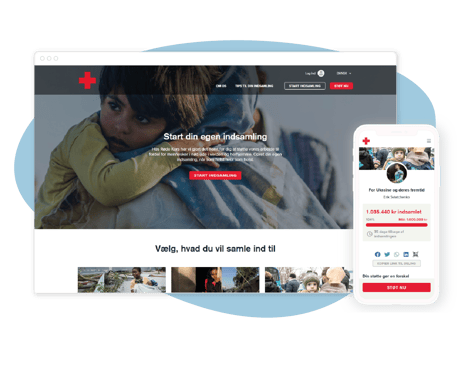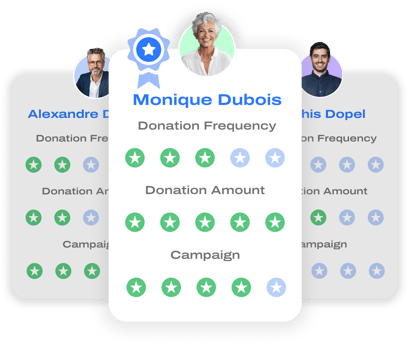In the field of fundraising, charities are constantly seeking innovative approaches to maximise their impact and engage a broader donor base. One strategy that has gained significant traction in recent years is peer to peer fundraising.
This method enables individuals to raise funds for a worthy cause. They can do so by utilising their personal connections to spread the word and gather donations on your behalf.
Peer-to-Peer fundraising offers multiple benefits for charities. It allows you to improve relationships with current donors, increase your awareness, boost your donor acquisition, among many other benefits.

Peer to peer fundraising has a reputation for effectively acquiring new donors. It extends your organisation's reach to the network of your supporters. These may be people who have never heard of your organisation and, despite that, decide to donate just because the ask came from a friend, family member or colleague.
When charities and nonprofits harness the energy and dedication of passionate supporters to raise funds on their behalf, they attract many new donors, often not directly connected to their existing target audience. These prospective donors, representing individuals who have shown interest and taken action, hold the potential to become not only financial contributors but also devoted advocates. However, effectively navigating this transition requires a thoughtful and strategic approach.
In this article, we delve into the crucial steps and strategies that charities can employ to nurture and convert new donors acquired through peer-to-peer fundraising campaigns into enduring pillars of support. We will explore:
- The potential of donor acquisition through Peer to Peer fundraising.
- 3 best practices to activate new donors from your Peer to Peer fundraising efforts:
1. Should you try to convert fundraisers into regular givers?
2. Should you try to convert donors into regular donors?
3. Score your new donors before trying to convert them.
The potential of donor acquisition through Peer to Peer fundraising.
Let's start from the beginning and have a closer look at one of the peer to peer fundraising campaigns organised by the Red Cross, which mobilised more than 35,000 supporters. When the war in Ukraine began, the Danish Red Cross created an appeal to raise funds to help the victims affected by the war. By simply looking at the numbers, the campaign was overall a massive success:
 A diverse bunch of individuals and businesses rallied together to support this appeal. While the common Red Cross supporters, who had a solid understanding of the organisation's mission, collected donations for families in need, an unexpected group of contributors emerged.
A diverse bunch of individuals and businesses rallied together to support this appeal. While the common Red Cross supporters, who had a solid understanding of the organisation's mission, collected donations for families in need, an unexpected group of contributors emerged.
Athletes, social media influencers, actors, and other individuals who typically reside outside the traditional Red Cross audience stepped forward to give their support. The remarkable response resulted in donations from over 35,000 people, including many who typically did not engage with the Red Cross. This proved the broadened reach and appeal of the cause.

As you can see, peer to peer fundraising can undoubtedly provide significant results, including new donors you had not reached before. But failing to capitalise on these new and one-time donors through effective follow-up can result in a colossal missed opportunity. These new donors represent individuals who have already expressed interest in your cause and demonstrated their willingness to engage.
By neglecting to nurture these connections in the right way, you risk leaving potential supporters, donors, or advocates untapped. A thoughtful and timely follow-up strategy can transform them into invaluable assets for your charity.
So what is the right approach to follow up with these new donors you have reached? Let’s look at 3 best practices to follow.
3 best practices to activate new donors from your Peer to Peer fundraising efforts.
You acquired new donors through peer-to-peer fundraising, now what?
As you may have understood, peer to peer fundraising, no matter the appeal, is great for donor acquisition. Donors which most likely aren’t in your database already. The big question is, what should you do with them?
Let's start by dividing these contacts into two groups: the donors and the fundraisers.
 Fundraisers involved in peer to peer campaigns are often deeply motivated by the mission and have a profound understanding of the charity's positive influence. Their decision to fundraise for your organisation might stem from a personal connection they have with your cause. Moreover, fundraisers typically select charities they trust and aim to make a meaningful impact through their efforts.
Fundraisers involved in peer to peer campaigns are often deeply motivated by the mission and have a profound understanding of the charity's positive influence. Their decision to fundraise for your organisation might stem from a personal connection they have with your cause. Moreover, fundraisers typically select charities they trust and aim to make a meaningful impact through their efforts.
 On the other hand, donors may not always be familiar with your charity. While a strong brand certainly increases the likelihood of receiving donations, donors often prioritise the individual fundraisers rather than the specific charity receiving the donation. Whether it’s the Red Cross or UNICEF, donors contribute based on their connection and trust in the fundraisers themselves.
On the other hand, donors may not always be familiar with your charity. While a strong brand certainly increases the likelihood of receiving donations, donors often prioritise the individual fundraisers rather than the specific charity receiving the donation. Whether it’s the Red Cross or UNICEF, donors contribute based on their connection and trust in the fundraisers themselves.
1. Should you try to convert fundraisers into regular givers?
Your fundraisers have already done a lot for your charity, as they have already dedicated their time, energy, and network to support your cause. It's highly likely that they have even made their own donations, further contributing to your fundraising efforts. So the best approach would be to avoid pushing them to become regular donors. Instead, focus on cultivating long-term relationships with these fundraisers, transforming them into loyal ambassadors who will return to support your organisation in the future.

Fundraisers often possess a higher value than regular donors in terms of their contributions, and they also bring in a significant number of new donors. Therefore, it’s crucial to effectively communicate how the funds they raised have been utilised. Show and articulate the impact they have helped create, expressing your gratitude and pride in their decision to fundraise for your cause.
2. Should you try to convert donors into regular donors?
Certainly, it is tempting to try and convert acquired donors from a peer-to-peer fundraising event or campaign into regular donors. Especially if you have a substantial number of them who have already made a donation. However, it's important to bear in mind that the donors tend to donate to the fundraiser rather than to the charity itself. As a result, converting these individuals into regular donors may require considerable time and effort, as they might have limited knowledge about your organisation and its impact.
It’s essential not to assume that simply handing over these contacts to a telemarketing agency after the peer-to-peer campaign will generate a high conversion rate of donors into monthly contributors. Instead, add the donors into your communication flow and integrate them into your ongoing outreach efforts. Educate them about your organisation's work and cause, providing insights that showcase the impact they have made through their donation.
By incorporating them into your communication flow, you have the opportunity to nurture these donors, gradually building their understanding and connection to your mission. Show them tangible examples of the impact they have been a part of and express gratitude for their support. This patient and strategic approach will help establish a stronger foundation for converting them into regular donors over time.
3. Score your new donors before trying to convert them:
After establishing a solid relationship with your new donors, the next step is to focus on converting them into regular givers. While peer-to-peer fundraising brings in a diverse range of prospective donors, it's important to acknowledge that not all of them may be interested in supporting your organisation on a monthly basis. Despite the ongoing communication efforts.
To find the donors who are likely to convert, set parameters to identify potential new regular donors. Here are some examples of parameters to consider:
- Donation Frequency: Analyse the donors' giving patterns during the Peer-to-Peer campaign. Look for individuals who have consistently donated multiple times or have shown a higher level of engagement.
- Donation Amount: Identify donors who have made larger contributions during the campaign, as it could indicate a higher level of commitment and capacity for regular giving.
- Campaigns: It is possible that certain peer to peer campaigns may attract donors who closely resemble your typical regular supporters. Start by reaching out to new donors from campaigns which are most aligned with your cause and mission.
- Engagement with Communications: Assess the level of interaction and engagement of donors with your communication materials. Look for individuals who have opened emails, clicked on links, or actively participated in online events.
- Alignment with the Mission: Consider donors who have expressed a strong empathy for your charity's mission and have demonstrated a clear understanding of the impact their donations can make.
By defining and applying these parameters, you can identify approximately the 20% of donors from your database who are most likely to convert into regular donors. This approach helps you focus and customise your giving program to nurture and encourage potential donors to make regular donations.
If you are looking for more information on how to improve your regular giving program, check out our article with tips for an effective regular giving strategy.

In conclusion, peer to peer fundraising serves as a powerful tool in your donor acquisition strategy and expanding your donor base. It is essential to capitalise on this opportunity by effectively communicating your organisation's mission and impact to every new donor that enters your database. However, it's important to recognise that not all donors can contribute monthly. Fundraisers should still be motivated to keep working in that role.
By focusing on the approximately 20% of donors identified through relevant parameters as the most likely to convert, you can strategically target your efforts and witness a growth in your recurring donor database based on the new supporters generated from your peer to peer activities.
Do you want to know more about how to welcome your new donors? Read our article!
